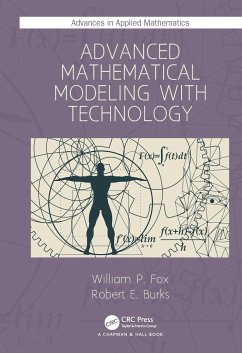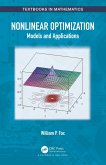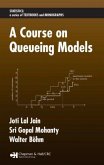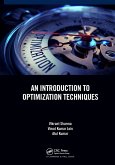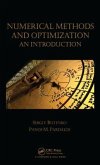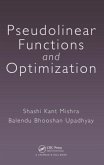- Gebundenes Buch
- Merkliste
- Auf die Merkliste
- Bewerten Bewerten
- Teilen
- Produkt teilen
- Produkterinnerung
- Produkterinnerung
Mathematical modeling is both a skill and an art and must be practiced in order to maintain and enhance the ability to use those skills. This book will be of interest to instructors and students offering courses focused on discrete modeling or modeling for decision making.
Andere Kunden interessierten sich auch für
![Nonlinear Optimization Nonlinear Optimization]() William P FoxNonlinear Optimization120,99 €
William P FoxNonlinear Optimization120,99 €![A Course on Queueing Models A Course on Queueing Models]() Joti Lal JainA Course on Queueing Models179,99 €
Joti Lal JainA Course on Queueing Models179,99 €![Delayed and Network Queues Delayed and Network Queues]() Aliakbar Montazer HaghighiDelayed and Network Queues119,99 €
Aliakbar Montazer HaghighiDelayed and Network Queues119,99 €![Uncertainty Modeling and Analysis in Engineering and the Sciences Uncertainty Modeling and Analysis in Engineering and the Sciences]() Bilal M AyyubUncertainty Modeling and Analysis in Engineering and the Sciences180,99 €
Bilal M AyyubUncertainty Modeling and Analysis in Engineering and the Sciences180,99 €![An Introduction to Optimization Techniques An Introduction to Optimization Techniques]() Vikrant SharmaAn Introduction to Optimization Techniques146,99 €
Vikrant SharmaAn Introduction to Optimization Techniques146,99 €![Numerical Methods and Optimization Numerical Methods and Optimization]() Sergiy ButenkoNumerical Methods and Optimization115,99 €
Sergiy ButenkoNumerical Methods and Optimization115,99 €![Pseudolinear Functions and Optimization Pseudolinear Functions and Optimization]() Shashi Kant MishraPseudolinear Functions and Optimization219,99 €
Shashi Kant MishraPseudolinear Functions and Optimization219,99 €-
-
-
Mathematical modeling is both a skill and an art and must be practiced in order to maintain and enhance the ability to use those skills. This book will be of interest to instructors and students offering courses focused on discrete modeling or modeling for decision making.
Hinweis: Dieser Artikel kann nur an eine deutsche Lieferadresse ausgeliefert werden.
Hinweis: Dieser Artikel kann nur an eine deutsche Lieferadresse ausgeliefert werden.
Produktdetails
- Produktdetails
- Verlag: Taylor & Francis Ltd (Sales)
- Seitenzahl: 557
- Erscheinungstermin: 20. Mai 2021
- Englisch
- Abmessung: 234mm x 156mm x 32mm
- Gewicht: 975g
- ISBN-13: 9780367494421
- ISBN-10: 0367494426
- Artikelnr.: 61946436
- Herstellerkennzeichnung
- Libri GmbH
- Europaallee 1
- 36244 Bad Hersfeld
- gpsr@libri.de
- Verlag: Taylor & Francis Ltd (Sales)
- Seitenzahl: 557
- Erscheinungstermin: 20. Mai 2021
- Englisch
- Abmessung: 234mm x 156mm x 32mm
- Gewicht: 975g
- ISBN-13: 9780367494421
- ISBN-10: 0367494426
- Artikelnr.: 61946436
- Herstellerkennzeichnung
- Libri GmbH
- Europaallee 1
- 36244 Bad Hersfeld
- gpsr@libri.de
Dr. William P. Fox is currently a visiting professor of Computational Operations Research at the College of William and Mary. He is an emeritus professor in the Department of Defense Analysis at the Naval Postgraduate School and teaches a three-course sequence in mathematical modeling for decision making. He received his Ph.D. in Industrial Engineering from Clemson University. He has taught at the United States Military Academy for twelve years until retiring and at Francis Marion University where he was the chair of mathematics for eight years. He has many publications and scholarly activities including twenty plus books and one hundred and fifty journal articles. Colonel (R) Robert E. Burks, Jr., Ph.D. is an Associate Professor in the Defense Analysis Department of the Naval Postgraduate School (NPS) and the Director of the NPS' Wargaming Center. He holds a Ph.D. in Operations Research from the Air Force Institute of Technology. He is a retired logistics Army Colonel with more than thirty years of military experience in leadership, advanced analytics, decision modeling, and logistics operations who served as an Army Operations Research analyst at the Naval Postgraduate School, TRADOC Analysis Center, United States Military Academy, and the United States Army Recruiting Command.
1. Perfect Partners: Mathematical Modeling and Technology. 1.1. Overview of
Some Real Big Problems and The Process of Mathematical Modeling. 1.2. The
Modeling Process. 1.3. Illustrative Examples. 1.4. Technology. 1.5.
Exercises. 1.6 Projects. 1.7. References and Suggested Future Readings. 2.
Review of Modeling with Discrete Dynamical Systems and Modeling Systems of
DDS. 2.1. Introduction and Review of Modeling with Discrete Dynamical
Systems. 2.2. Equilibrium and Stability Values and Long-Term Behavior. 2.3.
Introduction to Systems of Discrete Dynamical Systems. 2.4. Iteration and
Graphical Solution. 2.5. Modeling of Predator - Prey Model, Sir Model, and
Military Models. 2.6. Technology Examples for Discrete Dynamical Systems.
2.7. Exercises. 2.8. Projects. 2.9. References and Suggested Future
Readings. 3. Modeling with Differential Equations. 3.1. Applied First Order
Models. 3.2. Slope Fields and Qualitative Assessments of Autonomous First
Order ODE. 3.3 Analytical Solution to 1st Order ODEs. 3.4 Numerical Methods
for Solutions to 1st Order Odes with Technology. 3.5. Technology Examples
for Ordinary Differential Equations. 3.6. Exercises. 3.7. Projects. 3.8.
References and Suggested Future Readings. 4. Modeling System of Ordinary
Differential Equations. 4.1. Introduction. 4.2. Applied Systems of
Differential Equations. 4.3. Qualitative Assessment of Autonomous Systems
of First Order Differential Equations. 4.4. Solving Homogeneous and
Non-Homogeneous Systems. 4.5. Technology Examples for Systems of Ordinary
Differential Equations. 4.6. Exercises. 4.7. Projects. 4.8. References and
Suggested Future Readings. 5. Regression and Advanced Regression Methods
and Models. 5.1. Introduction. 5.2. Nonlinear Regression. 5.3. Technology
Examples for Regression. 5.4. Logistics Regression Models. 5.5. Technology
Examples for Poisson Regression. 5.6. Exercises. 5.7. Projects. 5.8.
References and Suggested Future Readings. 6. Linear Integer and Mixed
Integer Programming. 6.1. Introduction. 6.2. formulating Linear Programming
Problems. 6.3. Graphical Linear Programming. 6.4. Technology Examples for
Linear Programming. 6.5. Linear Programming Case Study. 6.6. Sensitivity
Analysis with Technology. 6.7. Exercises. 6.8. Projects. 6.9. References
and Suggested Further Reading. 7. Nonlinear Optimization Methods. 7.1.
Introduction. 7.2. Unconstrained Single Variable Optimization and Basic
Theory. 7.3. Models with Basic Applications of Max-Min Theory. 7.4.
Technology Examples for Nonlinear Optimization. 7.5. Single Variable
Numerical Search Techniques with Technology. 7.6. Exercises. 7.7. Projects.
7.8. References and Suggested Further Readings. 8. Multivariable
Optimization. 8.1. Introduction. 8.2. Unconstrained Optimization. 8.3.
Multivariable Numerical Search Methods for Unconstrained Optimization. 8.4.
Constrained Optimization. 8.5. inequality Constraints-Kuhn-Tucker (KTC)
Necessary/Sufficient Conditions. 8.6. Technology Examples for Computational
KTC. 8.7. Exercises. 8.8. Projects. 8.9. References and Suggested
Reading. 9. Simulation Models. 9.1. Introduction. 9.2. Random Number and
Monte Carlo Simulation. 9.3. Probability and Monte Carlo Simulation Using
Deterministic Behavior. 9.4. Deterministic Simulations in R and Maple. 9.5.
Probability and Monte Carlo Simulation Using Probabilistic Behavior. 9.6.
Applied Simulations and Queuing Models. 9.7. Exercises. 9.8. Projects. 9.9.
References and Suggested Readings. 10. Modeling Decision Making with
Multi-Attribute Decision Modeling with Technology. 10.1. Introduction.
10.2. Weighting Methods. 10.3. Pairwise Comparison by Saaty (AHP). 10.4.
Entropy Method. 10.5. Simple Additive Weights (Saw) Method. 10.6. Technique
of Order Preference by Similarly to the Ideal Solution (TOPSIS). 10.7.
Modeling of Ranking Units Using Data Envelopment Analysis (DEA) with Linear
Programming. 10.8. Technology for Multi-Attribute Decision Making. 10.9.
Exercises. 10.10. Projects. 10.11. References and Suggested Readings. 11.
Modeling with Game Theory. 11.1. Introduction to total Conflict (Zero-Sum)
Games. 11.2. Finding Alternate Optimal Solutions in A Two Person Zero-Sum
Game. 11.3. The Partial Conflict Game Analysis without Communication. 11.4.
Methods to Obtain the Equalizing Strategies. 11.5. Nash Arbitration Method.
11.6. Illustrative Modeling Examples of Zero-Sum Games. 11.7. Partial
Conflict Games Illustrative Examples. 11.8. Exercises. 11.9. Projects.
11.10. References and Suggested Readings. 12. Appendix Using R. Index
Some Real Big Problems and The Process of Mathematical Modeling. 1.2. The
Modeling Process. 1.3. Illustrative Examples. 1.4. Technology. 1.5.
Exercises. 1.6 Projects. 1.7. References and Suggested Future Readings. 2.
Review of Modeling with Discrete Dynamical Systems and Modeling Systems of
DDS. 2.1. Introduction and Review of Modeling with Discrete Dynamical
Systems. 2.2. Equilibrium and Stability Values and Long-Term Behavior. 2.3.
Introduction to Systems of Discrete Dynamical Systems. 2.4. Iteration and
Graphical Solution. 2.5. Modeling of Predator - Prey Model, Sir Model, and
Military Models. 2.6. Technology Examples for Discrete Dynamical Systems.
2.7. Exercises. 2.8. Projects. 2.9. References and Suggested Future
Readings. 3. Modeling with Differential Equations. 3.1. Applied First Order
Models. 3.2. Slope Fields and Qualitative Assessments of Autonomous First
Order ODE. 3.3 Analytical Solution to 1st Order ODEs. 3.4 Numerical Methods
for Solutions to 1st Order Odes with Technology. 3.5. Technology Examples
for Ordinary Differential Equations. 3.6. Exercises. 3.7. Projects. 3.8.
References and Suggested Future Readings. 4. Modeling System of Ordinary
Differential Equations. 4.1. Introduction. 4.2. Applied Systems of
Differential Equations. 4.3. Qualitative Assessment of Autonomous Systems
of First Order Differential Equations. 4.4. Solving Homogeneous and
Non-Homogeneous Systems. 4.5. Technology Examples for Systems of Ordinary
Differential Equations. 4.6. Exercises. 4.7. Projects. 4.8. References and
Suggested Future Readings. 5. Regression and Advanced Regression Methods
and Models. 5.1. Introduction. 5.2. Nonlinear Regression. 5.3. Technology
Examples for Regression. 5.4. Logistics Regression Models. 5.5. Technology
Examples for Poisson Regression. 5.6. Exercises. 5.7. Projects. 5.8.
References and Suggested Future Readings. 6. Linear Integer and Mixed
Integer Programming. 6.1. Introduction. 6.2. formulating Linear Programming
Problems. 6.3. Graphical Linear Programming. 6.4. Technology Examples for
Linear Programming. 6.5. Linear Programming Case Study. 6.6. Sensitivity
Analysis with Technology. 6.7. Exercises. 6.8. Projects. 6.9. References
and Suggested Further Reading. 7. Nonlinear Optimization Methods. 7.1.
Introduction. 7.2. Unconstrained Single Variable Optimization and Basic
Theory. 7.3. Models with Basic Applications of Max-Min Theory. 7.4.
Technology Examples for Nonlinear Optimization. 7.5. Single Variable
Numerical Search Techniques with Technology. 7.6. Exercises. 7.7. Projects.
7.8. References and Suggested Further Readings. 8. Multivariable
Optimization. 8.1. Introduction. 8.2. Unconstrained Optimization. 8.3.
Multivariable Numerical Search Methods for Unconstrained Optimization. 8.4.
Constrained Optimization. 8.5. inequality Constraints-Kuhn-Tucker (KTC)
Necessary/Sufficient Conditions. 8.6. Technology Examples for Computational
KTC. 8.7. Exercises. 8.8. Projects. 8.9. References and Suggested
Reading. 9. Simulation Models. 9.1. Introduction. 9.2. Random Number and
Monte Carlo Simulation. 9.3. Probability and Monte Carlo Simulation Using
Deterministic Behavior. 9.4. Deterministic Simulations in R and Maple. 9.5.
Probability and Monte Carlo Simulation Using Probabilistic Behavior. 9.6.
Applied Simulations and Queuing Models. 9.7. Exercises. 9.8. Projects. 9.9.
References and Suggested Readings. 10. Modeling Decision Making with
Multi-Attribute Decision Modeling with Technology. 10.1. Introduction.
10.2. Weighting Methods. 10.3. Pairwise Comparison by Saaty (AHP). 10.4.
Entropy Method. 10.5. Simple Additive Weights (Saw) Method. 10.6. Technique
of Order Preference by Similarly to the Ideal Solution (TOPSIS). 10.7.
Modeling of Ranking Units Using Data Envelopment Analysis (DEA) with Linear
Programming. 10.8. Technology for Multi-Attribute Decision Making. 10.9.
Exercises. 10.10. Projects. 10.11. References and Suggested Readings. 11.
Modeling with Game Theory. 11.1. Introduction to total Conflict (Zero-Sum)
Games. 11.2. Finding Alternate Optimal Solutions in A Two Person Zero-Sum
Game. 11.3. The Partial Conflict Game Analysis without Communication. 11.4.
Methods to Obtain the Equalizing Strategies. 11.5. Nash Arbitration Method.
11.6. Illustrative Modeling Examples of Zero-Sum Games. 11.7. Partial
Conflict Games Illustrative Examples. 11.8. Exercises. 11.9. Projects.
11.10. References and Suggested Readings. 12. Appendix Using R. Index
1. Perfect Partners: Mathematical Modeling and Technology. 1.1. Overview of
Some Real Big Problems and The Process of Mathematical Modeling. 1.2. The
Modeling Process. 1.3. Illustrative Examples. 1.4. Technology. 1.5.
Exercises. 1.6 Projects. 1.7. References and Suggested Future Readings. 2.
Review of Modeling with Discrete Dynamical Systems and Modeling Systems of
DDS. 2.1. Introduction and Review of Modeling with Discrete Dynamical
Systems. 2.2. Equilibrium and Stability Values and Long-Term Behavior. 2.3.
Introduction to Systems of Discrete Dynamical Systems. 2.4. Iteration and
Graphical Solution. 2.5. Modeling of Predator - Prey Model, Sir Model, and
Military Models. 2.6. Technology Examples for Discrete Dynamical Systems.
2.7. Exercises. 2.8. Projects. 2.9. References and Suggested Future
Readings. 3. Modeling with Differential Equations. 3.1. Applied First Order
Models. 3.2. Slope Fields and Qualitative Assessments of Autonomous First
Order ODE. 3.3 Analytical Solution to 1st Order ODEs. 3.4 Numerical Methods
for Solutions to 1st Order Odes with Technology. 3.5. Technology Examples
for Ordinary Differential Equations. 3.6. Exercises. 3.7. Projects. 3.8.
References and Suggested Future Readings. 4. Modeling System of Ordinary
Differential Equations. 4.1. Introduction. 4.2. Applied Systems of
Differential Equations. 4.3. Qualitative Assessment of Autonomous Systems
of First Order Differential Equations. 4.4. Solving Homogeneous and
Non-Homogeneous Systems. 4.5. Technology Examples for Systems of Ordinary
Differential Equations. 4.6. Exercises. 4.7. Projects. 4.8. References and
Suggested Future Readings. 5. Regression and Advanced Regression Methods
and Models. 5.1. Introduction. 5.2. Nonlinear Regression. 5.3. Technology
Examples for Regression. 5.4. Logistics Regression Models. 5.5. Technology
Examples for Poisson Regression. 5.6. Exercises. 5.7. Projects. 5.8.
References and Suggested Future Readings. 6. Linear Integer and Mixed
Integer Programming. 6.1. Introduction. 6.2. formulating Linear Programming
Problems. 6.3. Graphical Linear Programming. 6.4. Technology Examples for
Linear Programming. 6.5. Linear Programming Case Study. 6.6. Sensitivity
Analysis with Technology. 6.7. Exercises. 6.8. Projects. 6.9. References
and Suggested Further Reading. 7. Nonlinear Optimization Methods. 7.1.
Introduction. 7.2. Unconstrained Single Variable Optimization and Basic
Theory. 7.3. Models with Basic Applications of Max-Min Theory. 7.4.
Technology Examples for Nonlinear Optimization. 7.5. Single Variable
Numerical Search Techniques with Technology. 7.6. Exercises. 7.7. Projects.
7.8. References and Suggested Further Readings. 8. Multivariable
Optimization. 8.1. Introduction. 8.2. Unconstrained Optimization. 8.3.
Multivariable Numerical Search Methods for Unconstrained Optimization. 8.4.
Constrained Optimization. 8.5. inequality Constraints-Kuhn-Tucker (KTC)
Necessary/Sufficient Conditions. 8.6. Technology Examples for Computational
KTC. 8.7. Exercises. 8.8. Projects. 8.9. References and Suggested
Reading. 9. Simulation Models. 9.1. Introduction. 9.2. Random Number and
Monte Carlo Simulation. 9.3. Probability and Monte Carlo Simulation Using
Deterministic Behavior. 9.4. Deterministic Simulations in R and Maple. 9.5.
Probability and Monte Carlo Simulation Using Probabilistic Behavior. 9.6.
Applied Simulations and Queuing Models. 9.7. Exercises. 9.8. Projects. 9.9.
References and Suggested Readings. 10. Modeling Decision Making with
Multi-Attribute Decision Modeling with Technology. 10.1. Introduction.
10.2. Weighting Methods. 10.3. Pairwise Comparison by Saaty (AHP). 10.4.
Entropy Method. 10.5. Simple Additive Weights (Saw) Method. 10.6. Technique
of Order Preference by Similarly to the Ideal Solution (TOPSIS). 10.7.
Modeling of Ranking Units Using Data Envelopment Analysis (DEA) with Linear
Programming. 10.8. Technology for Multi-Attribute Decision Making. 10.9.
Exercises. 10.10. Projects. 10.11. References and Suggested Readings. 11.
Modeling with Game Theory. 11.1. Introduction to total Conflict (Zero-Sum)
Games. 11.2. Finding Alternate Optimal Solutions in A Two Person Zero-Sum
Game. 11.3. The Partial Conflict Game Analysis without Communication. 11.4.
Methods to Obtain the Equalizing Strategies. 11.5. Nash Arbitration Method.
11.6. Illustrative Modeling Examples of Zero-Sum Games. 11.7. Partial
Conflict Games Illustrative Examples. 11.8. Exercises. 11.9. Projects.
11.10. References and Suggested Readings. 12. Appendix Using R. Index
Some Real Big Problems and The Process of Mathematical Modeling. 1.2. The
Modeling Process. 1.3. Illustrative Examples. 1.4. Technology. 1.5.
Exercises. 1.6 Projects. 1.7. References and Suggested Future Readings. 2.
Review of Modeling with Discrete Dynamical Systems and Modeling Systems of
DDS. 2.1. Introduction and Review of Modeling with Discrete Dynamical
Systems. 2.2. Equilibrium and Stability Values and Long-Term Behavior. 2.3.
Introduction to Systems of Discrete Dynamical Systems. 2.4. Iteration and
Graphical Solution. 2.5. Modeling of Predator - Prey Model, Sir Model, and
Military Models. 2.6. Technology Examples for Discrete Dynamical Systems.
2.7. Exercises. 2.8. Projects. 2.9. References and Suggested Future
Readings. 3. Modeling with Differential Equations. 3.1. Applied First Order
Models. 3.2. Slope Fields and Qualitative Assessments of Autonomous First
Order ODE. 3.3 Analytical Solution to 1st Order ODEs. 3.4 Numerical Methods
for Solutions to 1st Order Odes with Technology. 3.5. Technology Examples
for Ordinary Differential Equations. 3.6. Exercises. 3.7. Projects. 3.8.
References and Suggested Future Readings. 4. Modeling System of Ordinary
Differential Equations. 4.1. Introduction. 4.2. Applied Systems of
Differential Equations. 4.3. Qualitative Assessment of Autonomous Systems
of First Order Differential Equations. 4.4. Solving Homogeneous and
Non-Homogeneous Systems. 4.5. Technology Examples for Systems of Ordinary
Differential Equations. 4.6. Exercises. 4.7. Projects. 4.8. References and
Suggested Future Readings. 5. Regression and Advanced Regression Methods
and Models. 5.1. Introduction. 5.2. Nonlinear Regression. 5.3. Technology
Examples for Regression. 5.4. Logistics Regression Models. 5.5. Technology
Examples for Poisson Regression. 5.6. Exercises. 5.7. Projects. 5.8.
References and Suggested Future Readings. 6. Linear Integer and Mixed
Integer Programming. 6.1. Introduction. 6.2. formulating Linear Programming
Problems. 6.3. Graphical Linear Programming. 6.4. Technology Examples for
Linear Programming. 6.5. Linear Programming Case Study. 6.6. Sensitivity
Analysis with Technology. 6.7. Exercises. 6.8. Projects. 6.9. References
and Suggested Further Reading. 7. Nonlinear Optimization Methods. 7.1.
Introduction. 7.2. Unconstrained Single Variable Optimization and Basic
Theory. 7.3. Models with Basic Applications of Max-Min Theory. 7.4.
Technology Examples for Nonlinear Optimization. 7.5. Single Variable
Numerical Search Techniques with Technology. 7.6. Exercises. 7.7. Projects.
7.8. References and Suggested Further Readings. 8. Multivariable
Optimization. 8.1. Introduction. 8.2. Unconstrained Optimization. 8.3.
Multivariable Numerical Search Methods for Unconstrained Optimization. 8.4.
Constrained Optimization. 8.5. inequality Constraints-Kuhn-Tucker (KTC)
Necessary/Sufficient Conditions. 8.6. Technology Examples for Computational
KTC. 8.7. Exercises. 8.8. Projects. 8.9. References and Suggested
Reading. 9. Simulation Models. 9.1. Introduction. 9.2. Random Number and
Monte Carlo Simulation. 9.3. Probability and Monte Carlo Simulation Using
Deterministic Behavior. 9.4. Deterministic Simulations in R and Maple. 9.5.
Probability and Monte Carlo Simulation Using Probabilistic Behavior. 9.6.
Applied Simulations and Queuing Models. 9.7. Exercises. 9.8. Projects. 9.9.
References and Suggested Readings. 10. Modeling Decision Making with
Multi-Attribute Decision Modeling with Technology. 10.1. Introduction.
10.2. Weighting Methods. 10.3. Pairwise Comparison by Saaty (AHP). 10.4.
Entropy Method. 10.5. Simple Additive Weights (Saw) Method. 10.6. Technique
of Order Preference by Similarly to the Ideal Solution (TOPSIS). 10.7.
Modeling of Ranking Units Using Data Envelopment Analysis (DEA) with Linear
Programming. 10.8. Technology for Multi-Attribute Decision Making. 10.9.
Exercises. 10.10. Projects. 10.11. References and Suggested Readings. 11.
Modeling with Game Theory. 11.1. Introduction to total Conflict (Zero-Sum)
Games. 11.2. Finding Alternate Optimal Solutions in A Two Person Zero-Sum
Game. 11.3. The Partial Conflict Game Analysis without Communication. 11.4.
Methods to Obtain the Equalizing Strategies. 11.5. Nash Arbitration Method.
11.6. Illustrative Modeling Examples of Zero-Sum Games. 11.7. Partial
Conflict Games Illustrative Examples. 11.8. Exercises. 11.9. Projects.
11.10. References and Suggested Readings. 12. Appendix Using R. Index

